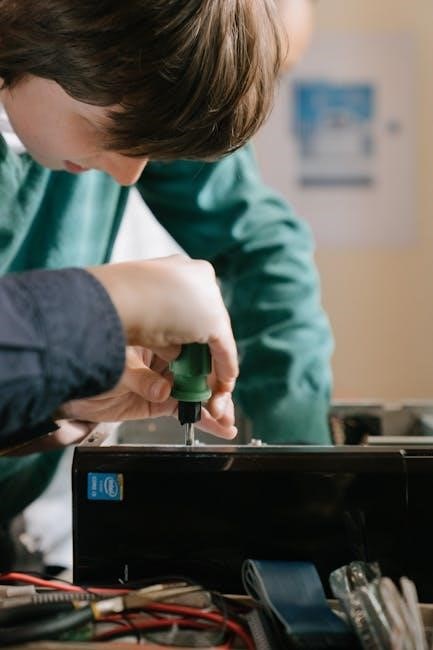Refer to the Wii operations manual for detailed solutions to common issues like disc read errors, connectivity problems, and syncing difficulties․ Clean the disc or lens, reset the AC adapter, or sync remotes properly․ If issues persist, consult the troubleshooting section or contact Nintendo support for further assistance․
Understanding the Wii Operations Manual Structure
The Wii Operations Manual is divided into clear sections to help users navigate and troubleshoot effectively․ It begins with an introduction to the console and its components, followed by a setup guide․ The manual includes detailed instructions for inserting and playing game discs, configuring system settings, and connecting controllers․ A dedicated troubleshooting section addresses common issues like disc read errors, Wi-Fi connectivity, and remote syncing problems․ Each section is designed to provide step-by-step solutions, ensuring users can resolve issues independently․ Additional resources, such as warranty information and safety precautions, are also included․ The manual emphasizes proper maintenance and care to extend the console’s lifespan․ For advanced users, it offers guidance on updating system software and accessing online features․ Referencing the manual regularly helps users make the most of their Wii experience while minimizing technical difficulties․

Key Sections of the Wii Instruction Manual
The Wii Instruction Manual contains essential sections designed to enhance user experience and troubleshooting․ The Getting Started section guides initial setup, including connecting hardware and configuring basic settings․ The System Settings chapter explains how to adjust audio, video, and network preferences․ Controllers & Accessories provides details on syncing remotes, calibrating the Wii Balance Board, and troubleshooting connectivity issues․ The Disc & Game Management section covers disc care, inserting games, and resolving read errors․ Power & Charging offers solutions for console and accessory power problems․ Additionally, the manual includes Safety Precautions to prevent hardware damage and health advice for comfortable gaming․ Advanced users can explore System Updates and Online Features for enhancing functionality․ Each section is structured to address specific needs, ensuring comprehensive coverage of the Wii’s operation and maintenance․ Regularly reviewing these sections helps users optimize their console’s performance and resolve issues efficiently․

Common Wii Troubleshooting Issues
Common issues include disc read errors, Wi-Fi connectivity problems, and Wii Remote syncing difficulties․ Solutions often involve cleaning discs, resetting the AC adapter, or checking connections․ Refer to the manual for detailed troubleshooting guidance․
Disc Read Errors and Solutions
Disc read errors are common issues with the Wii console․ These errors often occur due to dirty or scratched discs, which can prevent the laser from reading the game data properly․ To resolve this, clean the disc with a soft cloth and ensure it is free from fingerprints or debris․ If the issue persists, inspect the disc for scratches․ Light scratches can be buffed out with a disc repair kit, while deeper scratches may require professional attention․ Additionally, the Wii’s laser lens can accumulate dust, which may cause read errors․ Regularly cleaning the lens with a Wii laser lens cleaning disc can help maintain optimal performance․ For severe cases, resetting the console or referring to the Wii instruction manual for further troubleshooting steps is recommended․ Always handle discs by the edges to avoid further damage․
Wi-Fi and Bluetooth Connectivity Problems

Wi-Fi and Bluetooth connectivity issues with the Wii can often be resolved by checking the console’s hardware and network settings․ Ensure the Bluetooth board and Wi-Fi module are securely attached to the motherboard, as loose connections can cause malfunctions․ Restart your router and Wii console to refresh the network connection․ Verify that the Wii is updated to the latest system software, as outdated firmware can lead to connectivity problems․ If issues persist, perform a system reset by pressing and holding the power button for 10 seconds․ Additionally, ensure the Wii is placed away from physical obstructions and other electronic devices that may interfere with the signal․ For advanced troubleshooting, refer to the Wii operations manual for guidance on resetting network settings or reconfiguring the Wi-Fi connection․ If the problem persists, contact Nintendo support for further assistance․
Wii Remote and Nunchuk Syncing Issues
Syncing problems with the Wii Remote and Nunchuk can disrupt gameplay․ Ensure the Wii Remote is properly synced to the console by removing the battery cover and pressing the red sync button․ Restart the console and re-sync the remote․ For the Nunchuk, check the connector for dirt or damage and clean it gently․ If the Nunchuk isn’t responding, try syncing it while the Wii Remote is connected․ Replace batteries if they are low, as weak signals can cause sync issues․ If problems persist, reset the Wii Remote by pressing the red sync button on the remote and the console simultaneously․ Refer to the Wii operations manual for detailed steps on syncing and troubleshooting accessories․ Contact Nintendo support if the issue remains unresolved after these steps․


Power and Charging Troubleshooting
Power issues often stem from the AC adapter or console․ Unplug the adapter, wait, then reconnect to reset․ Ensure all connections are secure and free from damage․ If problems persist, consult the manual or contact Nintendo support for further assistance․
Resolving Power Issues with the Wii Console

Power issues with the Wii console can often be resolved by resetting the AC adapter․ Unplug it from both the console and the power outlet, then wait for at least 30 seconds before reconnecting․ Ensure all connections are secure and free from damage or debris․ If the console still does not power on, check the power button for proper function or try using a different outlet to rule out electrical issues․ For persistent problems, refer to the Wii operations manual or contact Nintendo support for further assistance․ Regular maintenance and proper handling can help prevent such issues and ensure optimal performance of your Wii console․
AC Adapter Reset and Maintenance

Resetting the AC adapter is a simple yet effective solution for many Wii power issues․ To reset, unplug the adapter from both the console and the electrical outlet․ Allow it to sit for at least 30 seconds to discharge any residual power․ Reconnect the adapter securely to both the console and the outlet, ensuring a firm connection․ For maintenance, regularly inspect the adapter for signs of damage, such as frayed cords or bent prongs․ Avoid using damaged adapters, as they may cause instability or complete power failure․ If the adapter is damaged, replace it with an official Nintendo AC adapter to maintain compatibility and safety․ Proper care and periodic checks can extend the lifespan of your Wii’s power components and prevent unexpected shutdowns or malfunctions․

Advanced Wii Troubleshooting Techniques
Advanced troubleshooting involves system settings configuration, updating software, and navigating the Wii menu for detailed diagnostics․ Use the Home button for quick access to settings and updates to resolve complex issues effectively․
System Settings Configuration and Updates
Configuring system settings and performing updates are crucial for maintaining optimal Wii performance․ Access the Wii Settings from the main menu to adjust options like display settings, audio configurations, and parental controls․ Regularly updating your Wii’s software ensures compatibility with the latest games and features․ To update, navigate to the Wii Settings, select Wii System Update, and follow on-screen instructions․ Ensure your console is connected to the internet for a smooth update process․ Proper configuration prevents issues like display mismatch or audio delays․ Refer to the Wii manual for detailed guidance on each setting․ Updating also enhances security and functionality, keeping your Wii running efficiently․ Always restart your console after updates to apply changes․ If updates fail, check internet connectivity or consult the troubleshooting section for solutions․ Keeping your system updated is essential for a seamless gaming experience․
Wii Menu Navigation and Home Button Functions
Navigating the Wii Menu and utilizing the Home button effectively enhances your gaming experience․ The Wii Menu, accessible by pressing the Home button on the Wii Remote, provides quick access to settings, channels, and game information․ Use the Home button to pause games, adjust settings, or return to the main menu․ The Wii Remote’s directional pad and buttons allow easy navigation through menu options․ Customize your experience by organizing channels or accessing downloaded content․ For troubleshooting, the Home Menu offers options to reset settings or view system updates․ Regularly exploring the Wii Menu ensures familiarity with its features and helps resolve common issues promptly․ Refer to the Wii manual for detailed instructions on menu navigation and Home button functions to optimize your console’s performance and enjoy uninterrupted gameplay․ Proper use of these features ensures a smooth and enjoyable user experience․




